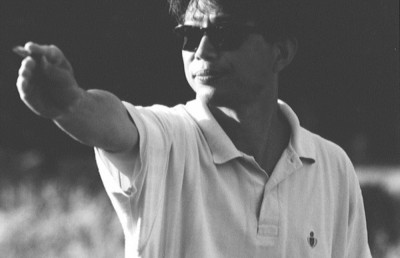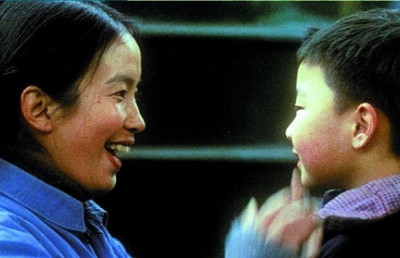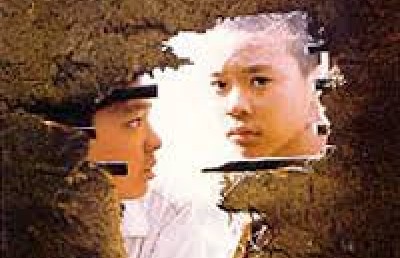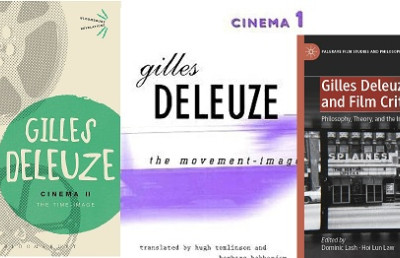Gilles Deleuze’s Bergsonian Film Project: Part 2
Cinema 2: The Time-Image
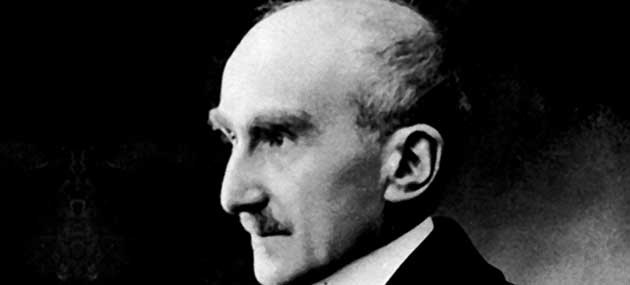
In his second book Deleuze tackles temporality in a more direct fashion. Although the book is considerably longer than the first (344 to 250 pages), Deleuze does not propose rigid or neat classifications. The central shift remains from a cinema that defined itself primarily through motion to one that concerned itself more directly with time. The time-image moved beyond motion by freeing itself of the “sensory-motor” link to a “pure optical and sound” (tactile) image. This emancipating of the senses concurred with a “direct relation with time and thought” ( Cinema 2 , 17). Deleuze spends considerable space discussing memory, especially Henri Bergson’s views on memory, because it forms an important part of the second book’s central concept: crystal-image (or time-image). In fact, one gets the sense that Deleuze’s two books align themselves with the Bergson book that most influenced Deleuze, Matter and Memory: movement-image (matter) and time-image (memory).
The Crystal-Image
Just as Bergson never gives us a finite definition of duration, Deleuze does not offer a singular definition of the time-image, or give a clear indication of what he means by a “direct image of time.” We can, however, offer the following description based on Deleuze’s many suggestive morsels, partial insights, and descriptive metaphors. The crystal-image, which forms the cornerstone of Deleuze’s time-image, is a shot that fuses the pastness of the recorded event with the presentness of its viewing. The crystal-image is the indivisible unity of the virtual image and the actual image. The virtual image is subjective, in the past, and recollected. The virtual image as “pure recollection” exists outside of consciousness, in time. It is always somewhere in the temporal past, but still alive and ready to be “recalled” by an actual image. The actual image is objective, in the present, and perceived. The crystal-image always lives at the limit of an indiscernible actual and virtual image.
With the crystal-image, Deleuze assigns a form of temporality that accounts for the “present/pastness” of the film image. The crystal-image shapes time as a constant two-way mirror that splits the present into two heterogeneous directions, “one of which is launched towards the future while the other falls into the past. Time consists of this split, and it is … time, that we see in the crystal” ( Cinema 2 , 81). David N. Rodowick sums up the time-image as one that fluctuates between actual and virtual, that records or deals with memory, confuses mental and physical time, actual and virtual, and is sometimes marked by incommensurable spatial and temporal links between shots ( Gilles Deleuze’s Time Machine, Durham and London: Duke University Press, 1997, 79-118).
The Crystal-Image and Bergsonian Memory
Bergson distinguished between two types of memory, habit formed memory and pure recollection (habitual memory and pure memory). The former is stored in the brain (matter), the service-house of action, and the latter within consciousness. (Bergson is vague on where, if not in the brain, pure memory is stored.) Bergson believes that nothing is forgotten. Pure memories live on forever. What happens is that the brain, with the aid of perception, censors the memories and selects the one’s that are most necessary for immediate action. Habit memory dominates because it has more pragmatic value. Pure memory, like the fundamental self, is less called for and resurfaces during moments of disinterestedness (dreaming for example), or on the rare moments when it can serve as a helpful guide to immediate perception (and becomes a recollected image). For example, when we drive a car the brain summons the habitualized ability to drive that we have memorized through repeated practice. The brain does not recall the “unrepeatable” individual instances of each driving lesson, complete with the unique memory of what occurred on each occasion.
However, pure perception and pure memory exist only in theory because perception is always effected by memory, and pure memory is dependent on the brain for materialization. According to David Gross there is an intriguing third type of memory that Bergson hinted at but did not expand upon. In the essay “Bergson, Proust, and the Revaluation of Memory,” David Gross describes this third memory as “unsolicited” independent memories that are disengaged from immediate action or perception (“Bergson, Proust, and the Revaluation of Memory,” International Philosophical Quarterly 25 no. 4 (1985): 369-380). A person dominated by these unsolicited recollections would be overwhelmed by the flood of images and hindered in their ability to cope with reality. Gross feels that Marcel Proust appropriated this third type of memory as “involuntary memory” for his mega-novel Remembrance of Things Past . For some reason, perhaps because it did not serve any practical or immediate application, Bergson did not develop this third type of memory any further. It does, however, have interesting possibilities for cinema. For example, involuntary memory is a key textual device in three of Tarkovsky’s films: Solaris , Mirror, and, most prominently, in Nostalghia .
Bergson’s third type of memory also has an interesting parallel to Deleuze’s discussion of memory and the time-image. According to Deleuze the proper equivalent for the time-image is not habitual or pure memory, but rather “the disturbances of memory and the failures of recognition” ( Cinema 2 , 55). Deleuze notes that from the start European cinema was more interested in failed forms of recognition: amnesia, hypnosis, hallucinations, madness, visions of dying, nightmares, and dreams (surrealism, dadaism, futurism, constructivism, psychoanalysis). The American action-image stood in contrast to the European search for this fragmentary vision: “European cinema saw in this a means of breaking with the ‘American’ limitations of the action-image, and also of reaching a mystery of time, of uniting image, thought and camera in a single ‘automatic subjectivity’, in contrast to the over-objective conception of the Americans” (55).
Deleuze’s polarity of action-image/American and time-image/European is not that clear cut (as the centrality to the time-image of Ophüls and Welles testifies). However, if one considers Bergson’s involuntary memory as the equivalent of Deleuze’s “disturbances of memory and the failures of recognition,” then habitual memory and pure recollection can be seen as paralleling realist, movement-image and the involuntary memory paralleling modernist and art film. In any sense, the importance Deleuze places on memory has obvious links to films that explore memory and consciousness through formal and thematic experimentation (Resnais, Welles, Tarkovsky, Sokurov, Ophuls, late Godard, and Hou Hsaio-hsien).
The “Non-Rational” Cut in the Time-Image
The incommensurable link between shots, which Deleuze calls the non-rational or irrational cut, signals an important difference between classical (movement-image) and modern (time-image) cinema:
“The so-called classical cinema works above all through linkage of images, and subordinates cuts to this linkage. On the mathematical analogy, the cuts which divide up two series of images are rational, in the sense that they constitute either the final image of the first series, or the first image of the second….rational cuts always determine commensurable relations between series of images and thereby constitute the whole rhythmic system and harmony of classical cinema….Time here is, therefore, essentially the object of an indirect representation, according to the commensurable relations and rational cuts which organize the sequence or linkage of movement-images….modern cinema can communicate with the old, and the distinction between the two can be very relative. However, it will be defined ideally by a reversal where the image is unlinked and the cut begins to have an importance in itself. The cut, or interstice, between two series of images no longer forms part of either of the two series: it is the equivalent of an irrational cut, which determines the non-commensurable relations between images” ( Cinema 2 , 213).
In the book Gilles Deleuze’s Time Machine , author D.W. Rodowick contrasts a scene from Keaton’s Sherlock Jr . (1924) with a scene from Chris Marker’s Le jetée to describe this vital difference between the movement-image and the time-image. In the Sherlock Jr . example Keaton moves from shot to shot across varying, illogical and precarious spaces: a garden, a busy street, a cliff side, a jungle with lions, train tracks in a desert, an ocean, a snowbank. Though these are nonsensical spaces, they are joined together in a rational order through match cuts and continuous screen direction. The effect is that time is subordinated to movement: “Time is measured only dynamically, as a process of action and reaction rebounding across contiguous spaces through match-cutting” (Rodowick, 3). Another more common example of this form of rational cutting across dislocated spaces can be seen in La Verié (1960, Henri-Georges Clouzet). In the sequence in question a romantic courtship between rebellious Dominique (Brigitte Bardot) and a conservative music student Gilbert (Sami Frey) is compressed through a series of shots linked by straight cuts. The sequence of short shots, which feature either both characters or one of them, cut from Dominique’s flat, to a café, to a phone booth, to a cinema theatre, to outside Dominique’s flat, and back inside her flat. Though the interval between shots is vague, the spatial and temporal uncertainty is rationally linked by the idea of romance and courtship.
Rodowick contrasts the Keaton example to a scene from La jetée, an odd choice given that La jetée is structured out of a series of (mainly) static photographs that are themselves “frozen in time.” I will offer an example from Hou Hsaio-hsien’s The Puppet Master (1993). The scene, which occurs approximately 90 minutes into the film, begins with a high angle shot looking down on a dirt road winding along a forest area. A couple we assume to be the central character Li Tienlu and his wife, walk along the road toward the camera, getting as close as long shot range before the image fades to black. The next shot is an extreme long shot of a suspended bridge amidst gorgeous forest foliage. Barely visible are two or three people walking across the bridge right to left, followed by a marching band. It is impossible to ascertain with certainty the physical or temporal link between these shots.
In summary, the classic movement-image is based on a rational ordering system (the continuity system) that is intended to make the story as legible and smooth running as possible. Even the terms of the continuity system, the match cut, the cut on action or movement, the 180-degree line, the reaction shot, the eye-line match, etc., are variations on movement. None of these terms relate directly to time (though time is implied). This is the basis of Deleuze’s “rational” cut.
The Crystal-Image and Style
Deleuze uses the crystal-image as an aesthetic rather than purely theoretical tool by ascribing stylistic qualities to it. [Even though, as D.N. Rodowick reminds us, “there are few ‘pure’ examples of films where direct images of time predominate,” 89.) Deleuze does this by ascribing different philosophical and psychological aspects of memories or crystal-images across filmmakers and genres. He compares, for example, the “perfect crystals” of Max Ophüls to Renoir’s “cracked crystal”( Cinema 2 , 85). Or, more generally, by the contrasting polarity of movement-image/American popular film and time-image/European modernist film. This demonstrates how Deleuze is as interested in questions of film style as in philosophy.
With regards film style, one would imagine the long take as a privileged style of the time-image, but this is not the case. Deleuze does not subscribe, as does Tarkovsky, to the notion that the long take, or time registered in the shot, is of a different value or type than time registered through montage. To Deleuze, this is a superficial distinction because, “the force or pressure of time goes outside the limits of the shot, and montage itself works and lives in time” ( Cinema 2 , 42). Hence time-image is not necessarily a cinema governed by long takes though it can be but a broader, philosophical separation from movement-image. However, much of what Deleuze says about depth-of-field in the crystal-image relates explicitly to the long take. In one of the book’s finest moments, chapter 5: “Peaks of present and sheets of past: fourth commentary on Bergson,” Deleuze gives an illuminating discussion of depth-of-field starting from Bazin’s realist theory and demonstrated through Orson Welles:
“We suggest that depth of field has many functions, and that they all come together in a direct time-image. The special quality of depth of field would be to reverse time’s subordination to movement and show time for itself. We are not saying that depth of field has the exclusive rights to the time-image….Our point is that depth of field creates a certain type of direct time-image that can be defined by memory, virtual regions of past, the aspects of each region. This would be less a function of reality than a function of remembering, of temporalization: not exactly a recollection but ‘an invitation to recollect…’” ( Cinema 2 , 109).
At this point Deleuze introduces an interesting idea to the discussion of depth of field that equally informs a discussion of the long take. Deleuze feels that in most cases where depth of field is necessary, there is a connection to memory. He again explicates this through Welles. The memory link is not necessarily literal, as in a flashback, or through psychological imagery. It is an attempt to evoke a memory out of an actual present or “of the exploration of a sheet of past from which these recollection-images will later arise” (109). With the poetic (and very Bergsonian) term “sheet of past” we can visualize a space where both actual and virtual image co-exist. As examples, he notes the high-angle shot in Citizen Kane “on an alcoholic Susan lost in the big room at the club in such a way as to force her to evoke”; and the opening low angle shot from The Trial that marks “the hero’s efforts as he searches at all costs for what the law is charging him with” ( Cinema 2 , 109-110). Deleuze as he always does with terms expands “sheet of past” to include characters, so that each character can also represent or carry their own sheet of past which may overlap with those of others. So that The Lady from Shanghai tells the story of a “hero caught in the past of others, captured, snapped up….We have three characters in turmoil, like three sheets of past who come to submerge the hero…( Cinema 2 , 113).
In Citizen Kane depth of field and the sequence shot is often used as a space in which the viewer can explore “virtual zones of the past” and choose memory elements to recall from the actual image (this can very clearly be related to Bazin’s conception of a “democratic” mise-en-scéne). In the Deleuzian sense depth of field is understood as a “function of remembering” and as a “figure of temporalization” [that] ….gives rise to all kinds of adventures in memory, which are not so much psychological accidents as misadventures of time…”( Cinema 2 , 110). It is also in this sense that Deleuze contests the idea that all films are set in the present. Deleuze goes to great length to disprove this notion: “The tracking shots of Resnais and Visconti, and Welles’s depth of field, carry out a temporalization of the image or form a direct time-image, which realizes the principle: the cinematographic image is in the present only in bad films” ( Cinema 2 , 39). This is central to the idea of Deleuze’s time-image. As Jacques Aumont states:
“…the cinematic apparatus implies not only the passage of time, a chronology into which we would slip as if into a perpetual present, but also a complex, stratified time in which we move through different levels simultaneously, present, past(s), future(s) -and not only because we use our memory and expectations, but also because, when it emphasises the time in which things take place, their duration, cinema almost allows us to perceive time” ( The Image , 129-130).
A Cinema of the Brain
Deleuze spends considerable parts of chapters 7 (“Thought and cinema”) and 8 (“Cinema, body and brain, thought”) discussing editing in relation to its role within classical and modern cinema, and to the idea of an intellectual cinema. Deleuze begins the discussion with the following interesting observation, “…from the outset, Christianity and revolution, the Christian faith and revolutionary faith, were the two poles which attracted the art of the masses” ( Cinema 2 , 171). Deleuze does not mean this to be a restrictive duality, since he notes remarkable differences within each group; for example, Rossellini, Bresson, and Ford within the Christians (I would add Dreyer, Tarkovsky, Lars von Trier, Rohmer, Schrader) and Rocha, Güney and Eisenstein within the revolutionaries (I would add Godard, Jancsó, Dovzhenko). At this point in the chapter Deleuze is discussing these directors in relation to thought and belief, and ascribes to modern cinema the function of restoring our (lost) belief in the world. “Whether we are Christians or atheists…we need reasons to believe in this world ( Cinema 2 , 172). Deleuze will discuss intellectual cinema only in the following chapter, but I noticed a commonality in the above names: with the possible exception of John Ford, the film’s of the above directors have been called (or could be) at one time or another, intellectual. (Ford would surely hate for his films to be even considered as being intellectual!) Given the great differences between them, it raises the question, what is an intellectual film? At this point the question is partly rhetorical, since there may not be an “answer” (or at least an easy one). However, it is tangentially related to the question of stylistic sensibility, and informs Deleuze’s next chapter.
The discussion of thought gives way in chapter 8 to a discussion of rational/irrational cutting and intellectual cinema. The use of rational/irrational here seems odd because it is used to define a cinema that includes a host of “intellectual” filmmakers. Only paragraphs before this statement Deleuze uses Resnais and Kubrick to argue for a new form of intellectual cinema (a “cinema of the brain”). Montage is assigned the function of restoring the “laws of the process of thought,” but thought does not necessarily align with the rational or irrational. Linking the irrational cut and the non-commensurable to the time-image does, however, make sense in relation to the earlier noted “disturbances of memory and the failures of recognition” (hypnosis, hallucinations, madness, nightmares, etc.) and the break from a “sensory-motor” link (emancipated senses). What these all have in common, though they at times may appear contradictory, is a flux-like sense of “letting go” which can be linked to creative expression.
What also seems to be bubbling below the surface of Deleuze’s rational/irrational duality is a parallel to Bergson’s epistemological duality of the intellect and intuition. In Bergson’s philosophy the intellect is connected to matter and spatialized time and intuition is connected to life and duration. The intellect, by nature, is a spatializing mechanism. To acquire knowledge it employs concepts, symbols, abstraction, analysis, and fragmentation. The intellect gives us a fragmented but necessary, pragmatic grasp of reality, whereas intuition is the means with which to grasp the essential element of reality: duration. Since it is the time-image that is able to give us fleeting moments of time (duration and “reality”), and the movement-image only an indirect representation of time, we can see a clear parallel between Bergson and Deleuze’s dualism: intellect = rational, intuition = irrational.
Conclusion
Deleuze’s two books are very much works of philosophy, but they are also, to an almost equal degree, concerned with film style. While his two cinema books argue for the practice of philosophy and concept building through cinema, the particular and varied philosophical sensibilities he discusses across his panoply of directors relate in the deepest sense possible to style. Deleuze feels that there is a “cinema of philosophy, a cinema of thought, which is totally new in the history of cinema and totally alive in the history of philosophy, creating, with his unique collaborators, a rare marriage between philosophy and cinema” (209). Hence with his cinema books we see two separate fields, philosophy and cinema, ultimately enriching each other.
Though Deleuze does not offer a single overriding philosophy or theory of time that can be easily applied to film analysis, there is much within his philosophical ideas that can be stimulating for an adventurous minded film theorist, historian, or academic. Deleuze, as did Bergson, has a visual writing style that is closer to literature than that of most philosophers. It is this evocative writing style that makes Deleuze a slippery fit for conventional film studies (especially the fairly recent cognitive school of film studies). In the least, Deleuze’s imagistic (and sometimes baffling) neologisms, concepts, and terms can be fruitfully used to form textual and interpretative schemata for certain temporal aspects of cinema (sheets of the past, set, crystal-image, any-space-whatevers).
There is a leap of faith in much of Deleuze’s writing and theoretical conjectures on this paradigmatic shift from movement-image to time-image. He does not prescribe value to them or say that one cancels the other out. Much of what he says is based in a belief that cinema has in fact changed the way we think and feel about time. This is understandable given the torrent of historical and cultural events that have shaped the 20th century. Deleuze hints at this when he says: “This is the first aspect of the new cinema [time-image]: the break in the sensory-motor link (action-image), and more profoundly in the link between man and the world [my emphasis]…”( Cinema 2 , 173). Here we sense a post-modern reverberation of failed modernity and the (temporary?) disappearance of Meaning, History, and Destiny. Or, by way of time, a return to Siegfried Kracauer’s call for a “redemption of physical reality.”



